China, Tibet. Three days trekking around the Kailash on the most difficult and highest pilgrim path in the world. Together with countless believing Tibetans and Indians we set off on the full moon day of the Saga-Dawa festival. We all had the goal to circle the holy mountain. With it we did not only want to erase our sins of the present life (would be too beautiful) but above all we wanted to experience the colourful world of Buddhism. That means prayer flags, decorated horses and yaks as well as Tibetans in traditional costumes. Prayer drums and prayer chains, incense offerings and small blessings fly through the air. The atmosphere on the pilgrim path is unique. Young and old mix, Tibetans and tourists run together and each meets the other with friendliness.
In my following article you will learn all kinds of interesting facts for your own Kora around the holy mountain. In addition to some useful recommendations for your packing list, I'll give you a few tips on how best to prepare for the dreaded pass at 5,630 m altitude.
Unassigned, unpaid advertising. The article contains affiliate links.
Table of Contents and Quick Navigation
Saga-Dawa - Buddha's Birthday, Day of Enlightenment and Day of Death
Kailash - Tibet's holy Mountain and Throne of the Gods
Kora around the Kailash
The most difficult Pilgrimage Route in the World
Three Days Trekking around Kailash
Starting Point Darchen
First Stage: From Darchen to Dira-Puk Monastery
Tarboche
Second Stage: from Dira-Puk Monastery to Zutul-Puk Monastery
Ascent to the Drölma-La Pass
Descent from Drölma-La Pass
Third Stage: from Zutul-Puk Monastery back to Darchen
Accommodation
Getting there
Preparing for the Altitude
Altitude Training
Packing List
Epilog
Saga-Dawa - Buddha's Birthday, Day of Enlightenment and Day of Death
The Saga-Dawa is the most important religious festival in Tibet. During this time every year a whole month is celebrated. Usually this takes place in June and especially on the full moon day. More precisely, not only one special event is honored on this day, but three: Buddha's birthday, the day of his death and the day of his enlightenment under the Bodhi tree.
The ceremonies on the full moon day at Mount Kailash are undoubtedly the highlight of the Saga Dawa. But the festival is not only celebrated around the holy mountain. Also in other places believers put up butter lamps, beautify the monasteries and temples or produce sand mandalas.
Kailash - Tibet's holy Mountain and Throne of the Gods
The Kailash (Tibetan: Kang Rinpoche - Snow Jewel) is a snow-covered pyramid-shaped mountain rising from the Tibetan plateau. Its summit at 6,714 m has never been climbed before. When the Chinese government offered Reinholt Messner an ascent in the 80s, he refused. For the summit of the throne of the gods - as the mountain is also called in Tibet - is a religious taboo. Hindus and Buddhists as well as followers of the ancient Tibetan Bon and Jain religions worship it. Due to its special form and location, which identify the Kailash as Mount Meru, it is one of the most important spiritual places and forms the cosmogony's world mountain in the centre of the universe.

Every year about 25,000 pilgrims come to Darchen to walk the Kora around the holy mountain, i.e. to circumnavigate the mountain once. Because the journey to Kailash is for Tibetans like the Hajj to Mecca is for Muslims. Once in a lifetime every believer should have completed the pilgrimage.
Kora around the Kailash
The Saga-Dawa feast is a time to do meritorious things and show generosity. On this occasion many believers come to the Kailash to walk the Kora around the holy mountain. A Kora stands for one revolution of the wheel of life from birth to death. And whoever walks the Kora once around the holy mountain Kailash erases all the sins of his present life. In addition, twelve orbits erase the sins of earlier lives. Those who finally walk the Kora 108 times come directly to paradise (Nirvana). The number 108 is a holy number in Buddhism. Especially believing Tibetans circle the Kailash in a series of prostrations.

The most difficult Pilgrimage Route in the World
The 53 km long pilgrim's path around Kailash runs at an altitude of 4,650 to 5,630 metres. Due to its altitude, it is the most difficult pilgrimage route in the world. Not all of them make the circumnavigation, many have to turn back due to acute altitude sickness. Nevertheless, the altitude is not the only thing that makes trekking around the holy mountain a challenge. Especially steep ascents and descents with icy spots, gravel or mud require some skill on the second day of the Kora. Furthermore you should plan a weather change with storm and snowfall when choosing your equipment. Even in midsummer.
The Kora around the Kailash is usually divided into three stages and walked clockwise. Only the followers of the old Bön faith circle the Kailash counterclockwise.
- Darks to Dira-Puk Monastery (20 km, 5-6 hours, 5050 m)
- to Zutul-Puk Monastery (18 km, 6-8 hours, 4820 m)
- back to Darchen (14 km, 3-4 hours, 4670 m)
The pilgrimage route around the Kailash was closed during the Cultural Revolution. It was not until 1981 that the route was reopened. Since 1985 also western foreigners are allowed to walk the Kora around the holy mountain again, but only with a guide and the appropriate permit.

Three Days Trekking around Kailash
Starting Point Darchen
Darchen is the starting and finishing point for trekking around the holy mountain. Here we make our last preparations for the Kora. That means we buy provisions and our guide organizes porters for the luggage. One carrier will carry the luggage of two persons, but a maximum of 15 kg. For each carrier we pay 990 Yuan to the government. The government then pays the porters afterwards. We do not know how much the porters actually get from the 990 yuan.

In the evening before the full moon day there is an excited mood on the main street. Many people are on the way. The shops and street traders offer prayer flags in all sizes. Consequently, rolled up flags pile up in shelves, on tables, benches and even on the loading areas of delivery vans. Trekking poles, hiking poles, water canisters, cooking equipment and oxygen bottles are also available. And those who don't buy prayer flags at the moment can enjoy themselves at one of the open-air billiard tables.
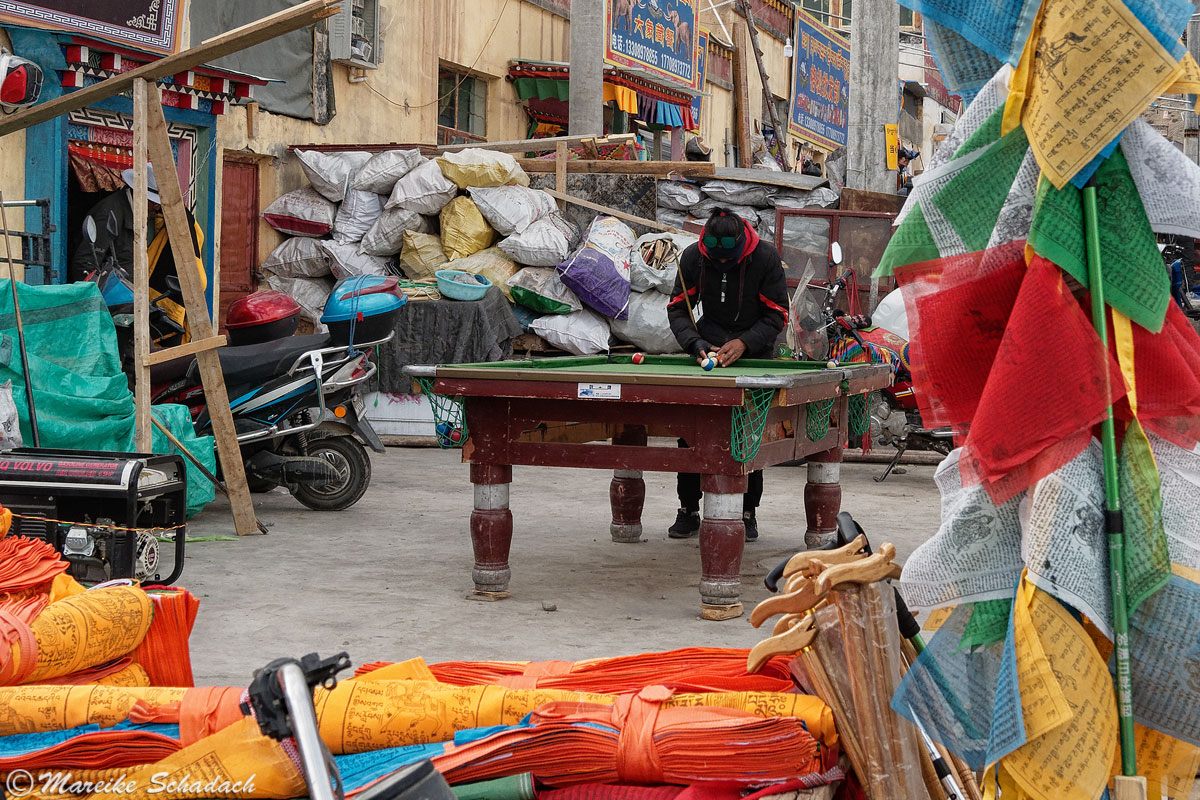
By the way: If you don't feel fit enough to walk the Kora around the holy mountain yourself, you can rent a horse with a horseman here in Darchen. In 2019, a horse with a horseman cost 24,000 yuan for three days.
First Stage: From Darchen to Dira-Puk Monastery
For the Saga-Dawa festival a new flagpole (Tarboche) will be erected at the foot of the Kailash on full moon day. Already in the early morning the pilgrims from Darchen stream to the Tarboche. There is an exuberant atmosphere on the pilgrim path, greetings are given and selfies are made. Meanwhile on the neighbouring gravel road cars honk their horns to Tarboche and pull a wide dust flag behind them.
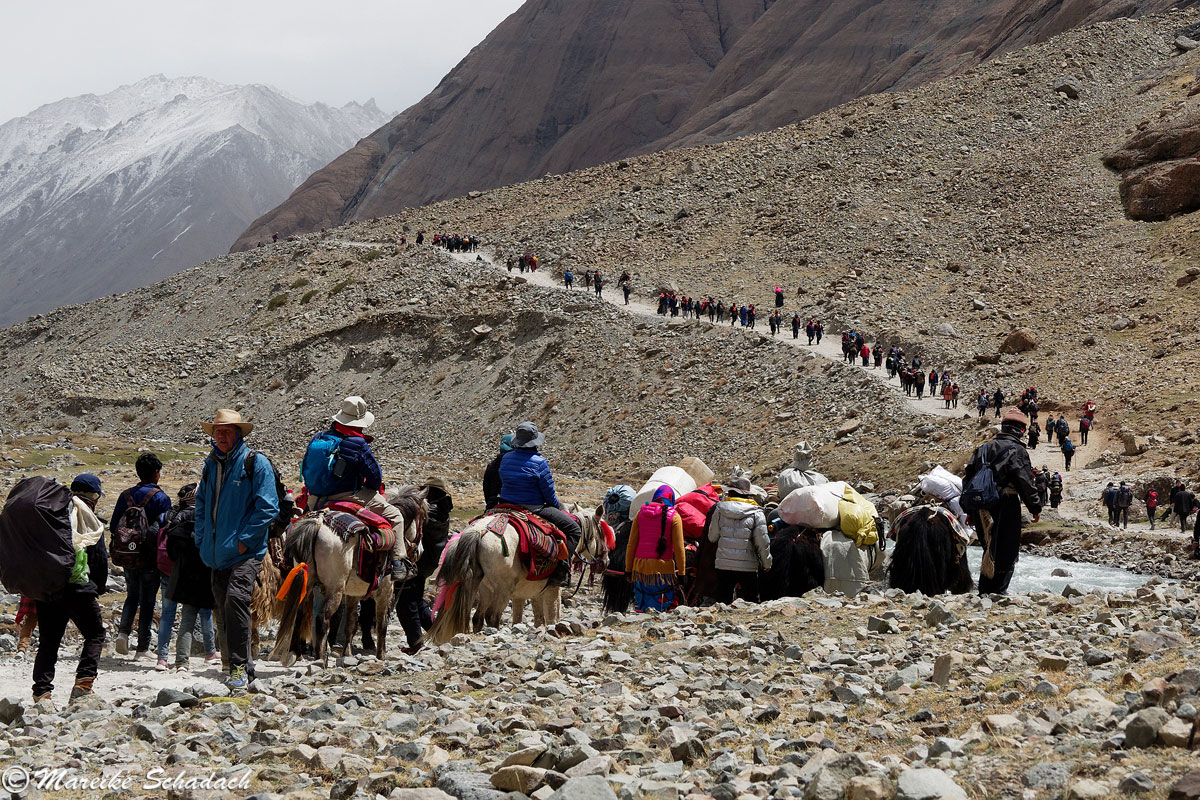
Most Tibetans are festively dressed with colorful chubas of colorful brocade and lots of jewelry, mainly turquoise. In addition, the women have woven colorful ribbons into their hair. Some of them then artfully placed the long braids around their heads. Many carry their prayer chains or prayer wheels in their hands and murmur prayers.
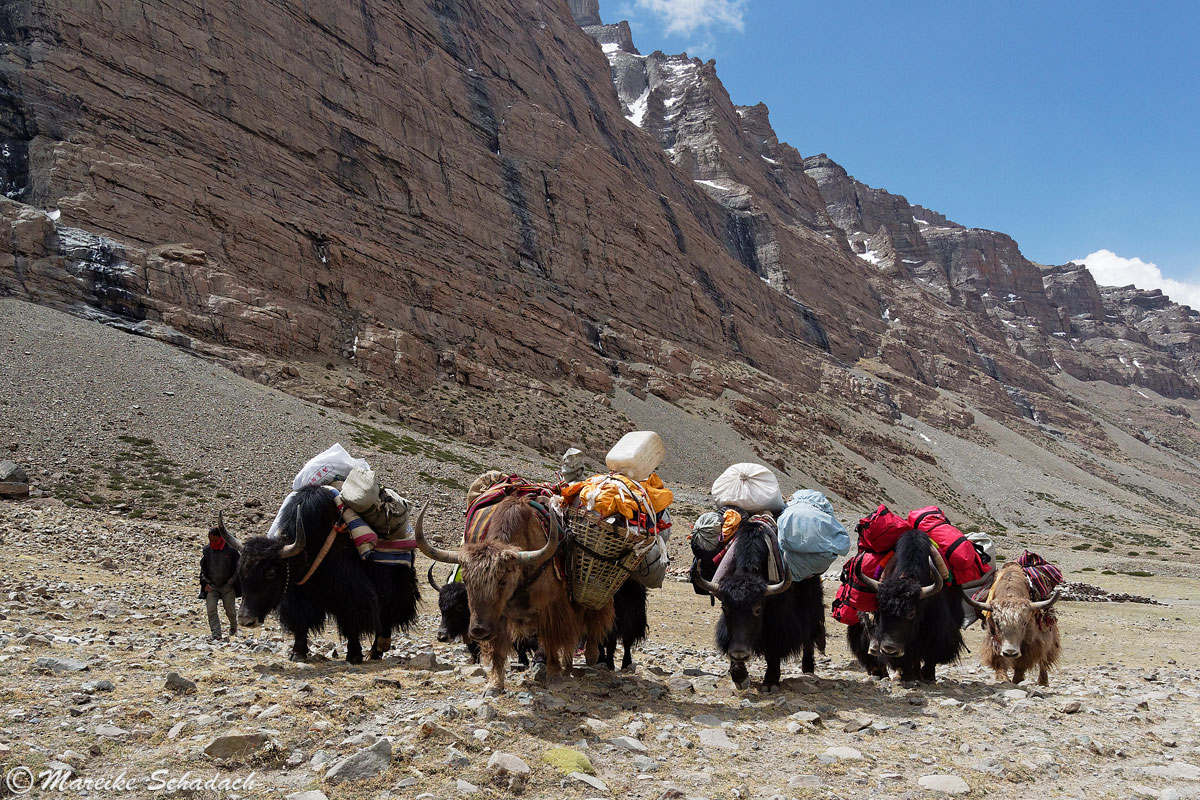
The pilgrimage begins north of Darchen. At first the path is lined with cairns and manisteins. After about an hour, you will reach a stupa decorated with prayer flags. Here is the first of four points for religious prostration. It is also the first point where the Kailash shows up. A good place for a break. The pilgrims pray, throw small blessings with the flying horse into the air or attach their prayer flags.
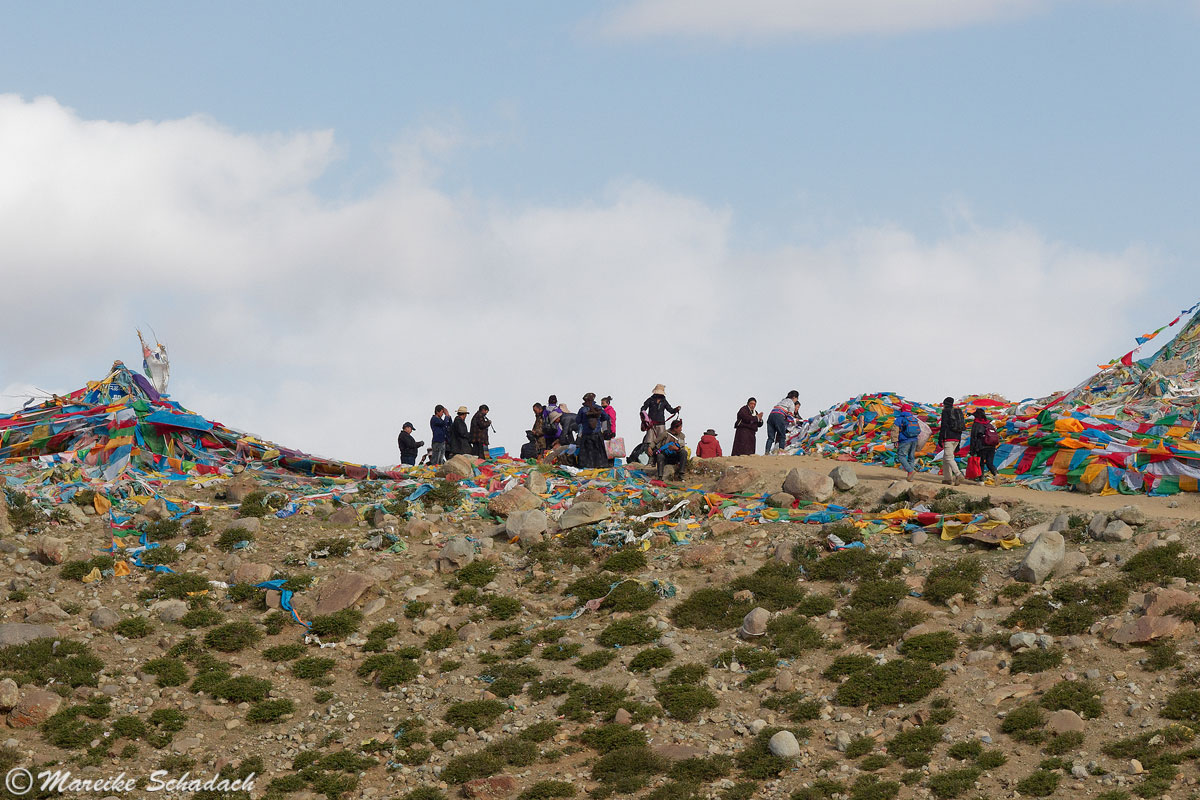
Tarboche
The Tarboche is about 7 km away from Darchen. This distance can either be covered within 2.5 hours on foot, or you can take the energy-saving Ecobus.
As we approach the Tarboche, we can already see the place for the flagpole from a distance. There a huge area has become a sea of prayer flags. On the way there traders offer prayer flags and blessings as well as food, drinks, jewellery and other souvenirs.
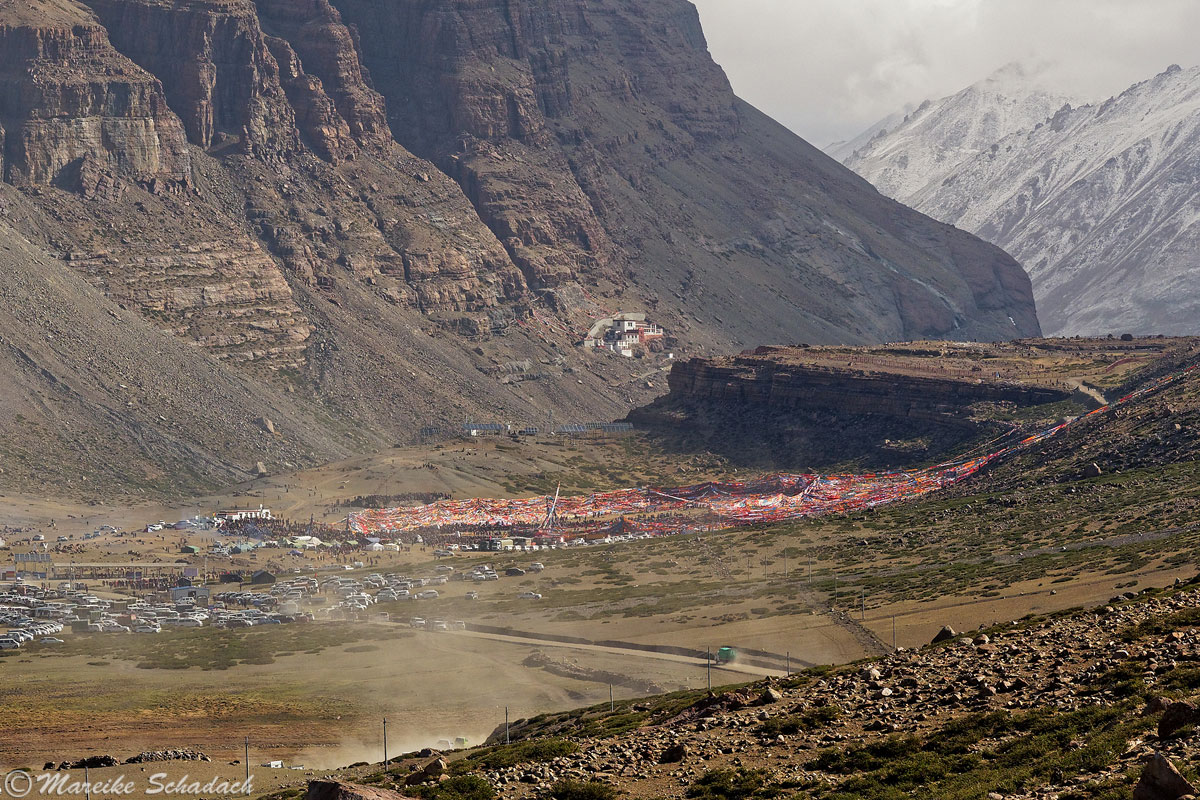
Suddenly we hear the crowd cheering in front of us. It is 10:30 am and the flagpole is hoisted. We see it only from a distance. But we also see that it suddenly no longer stands. Suddenly the mood is tense. No more photos may be taken. Normally it is allowed to take pictures here except for the police and the military. The cameras are checked by two passengers of our group, one even has to delete pictures. Our guide drives us in a hurry once clockwise around the Tarboche and then further along the pilgrim path. The second attempt to erect the mast we are not supposed to notice anymore. There is a simple reason for this: the Tibetans believe that it will bring bad luck if the mast falls down.


By the way: If you don't want to walk the complete 54 km around the Kailash, you can also walk the Kora here. Because 13 circles of the flagpole correspond to a Kora around the holy mountain.
Second Stage: from Dira-Puk Monastery to Zutul-Puk Monastery
That night it snowed. Now everything is covered with white icing sugar. More snow and wind are forecast for the afternoon. There are discussions in the group. Should we go or turn back? Finally we decide to go on and start at 7:15 am to the Drölma-La Pass. From now on it goes four hours uphill, up to 5,630 m altitude. Slowly the day awakes and first light bathes the mountain landscape in a great scenery. A woman with a baby on her back overtakes us, at the same time two children sprint past us. Meanwhile three believers move up the pass only with prostrations, over stones, through mud and snow. They wear thick gloves, padding on their knees and a padded apron. We overtake them and meanwhile have great respect. After two hours we take our first break in the heated tent, where we defrost our cold hands and feet.
Ascent to the Drölma-La Pass
After the break the way to the Drölma-La Pass becomes even steeper, so that I have to stop again and again and take a breather. During this time I see other exhausted pilgrims breathing from their oxygen bottles. On both sides of the way there are also many thrown away bottles. A woman is supported left and right and the pass is carried up rather than running herself. At this moment I am happy about my previous altitude training and the good altitude acclimatization we had before. Because up here the air has only about half the oxygen content as at sea level.

Shortly before the pass many prayer flags already hang. It is a stretch where pilgrims like to leave personal belongings. Besides shoes, bracelets and scarves we also find numerous sweets along the way. As soon as we arrive at the dreaded pass at 5,630 m altitude, there is great joy, selfies are made and prayer flags are hung up.


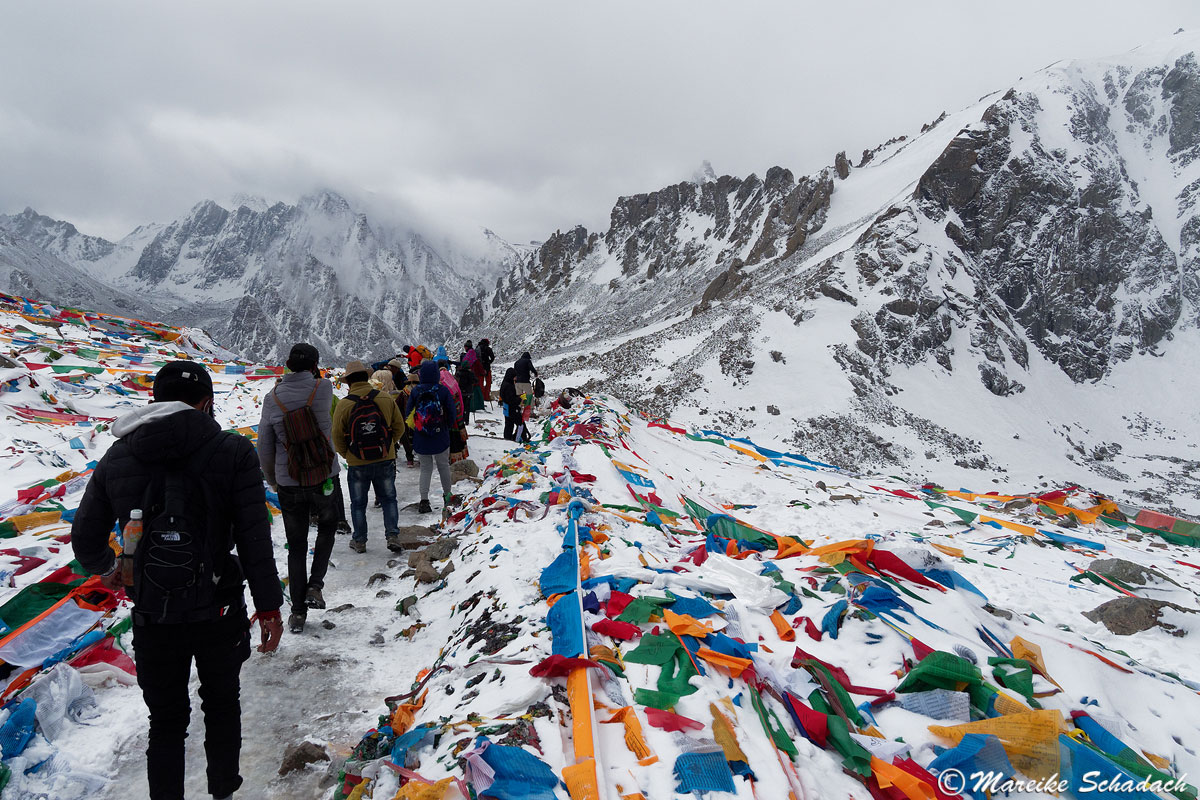
Descent from Drölma-La Pass
The way downhill is technically demanding. It is not only steep, but also smooth. Again and again we see pilgrims slipping. I am happy about my trekking poles, which give me stability on the icy spots. After my partner slipped, our Tibetan carrier intervenes: she gives one of my trekking poles to my partner, so that he has two, and takes me by the hand because I am smaller. I was really touched how she cared about our safety. She wouldn't let us out of her sight. And it really helped to support each other. Later I was well trained and was even able to help myself and support a Tibetan woman climbing.

We can already see the white supply tent from a distance. Shortly afterwards we warm up and fortify ourselves with tea and instant noodles. These are the only food in the tents. But while we almost wanted to rest on our laurels after crossing the pass, the weather outside has changed. The next three hours we are accompanied by frontal wind, snow and sleet. We were glad that the weather had not already changed at the pass and hurried to get to our accommodation. Afterwards our guide tells us that shortly after our departure in the morning no group of pilgrims left for the pass. Due to bad weather many pilgrims have turned around or waited a day.
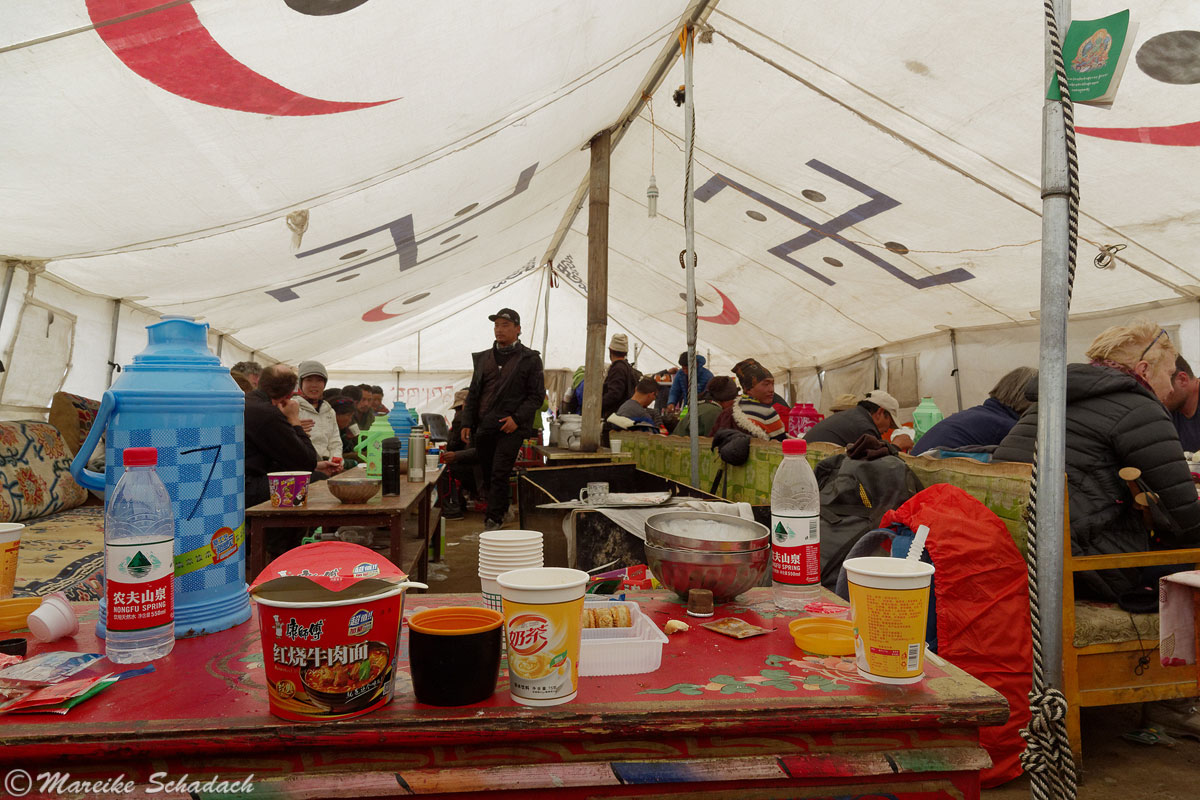
Third Stage: from Zutul-Puk Monastery back to Darchen
In the morning the sun welcomes us again, there is snow and the first pilgrims set off. We have a typical Tibetan breakfast: Naan (Tibetan bread) with omelette.
Afterwards we visit the monastery and start to our last day of the Kora. The landscape is breathtaking, the way leads along a wide river. On the right side of the road manis stones are piled up and we pass the fourth point for prostrations.
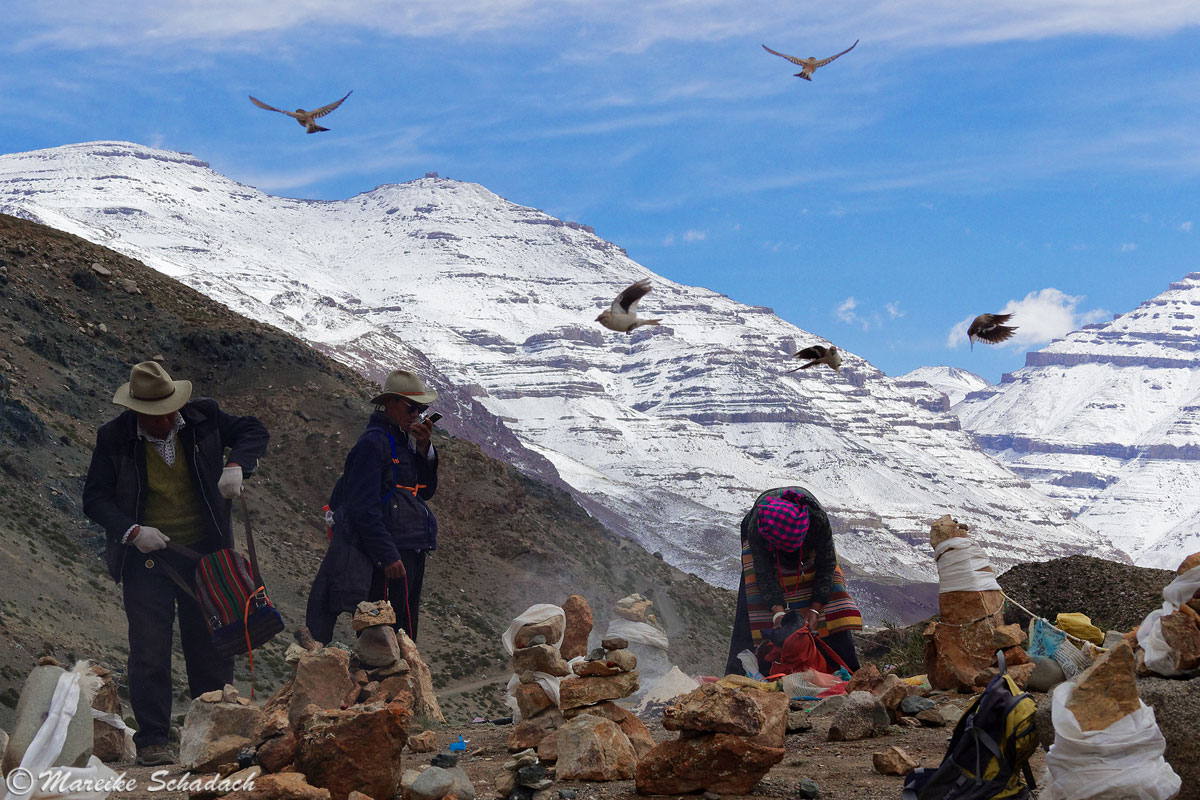
After about three hours we recognize the place Darchen in the distance. The last kilometres lead through a dry area, which seems to please the whistling bunnies very much. The ground is littered with holes in which we see the cute little animals disappear again and again.
The closer we get to Darchen, the heavier my legs get. We slow down more and more, dally and take many photos. The last steps of our trekking around the Kailash lead us to lunch in the restaurant where our stay in Darchen started four days ago.


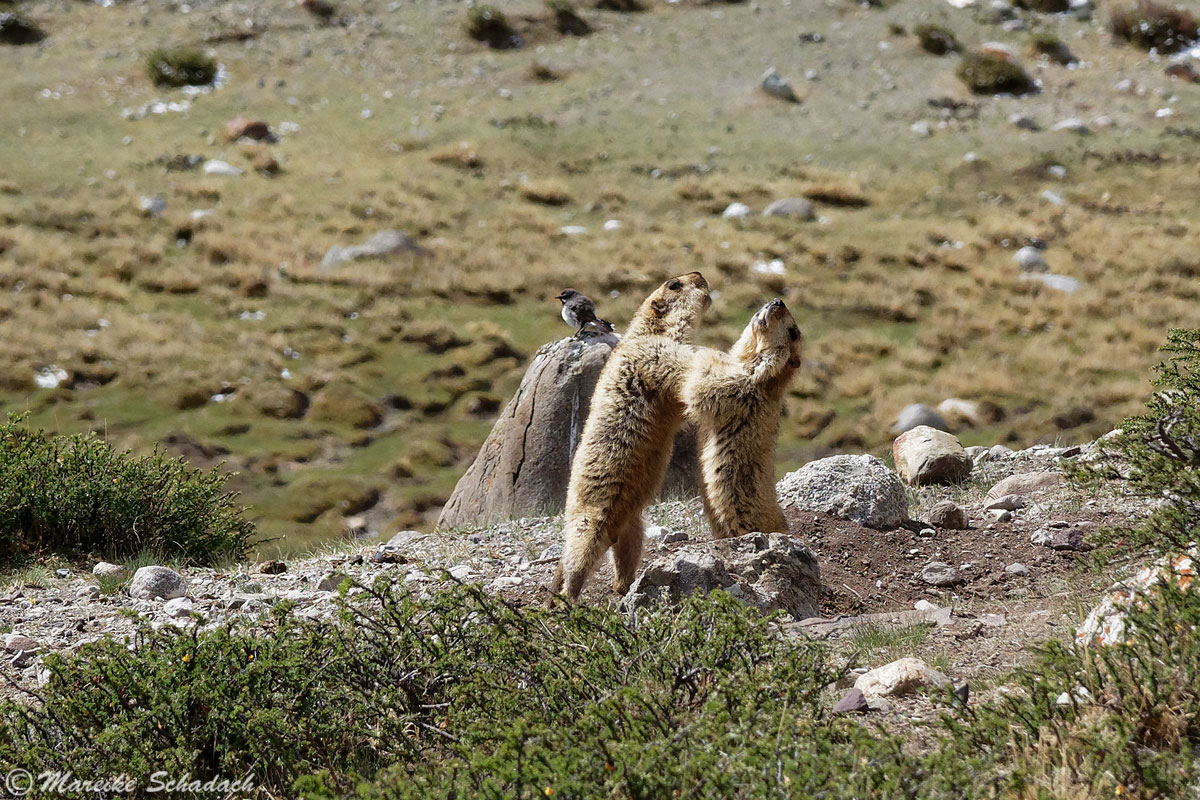
Accommodation
During the trekking around the Kailash we stayed overnight in simple guesthouses with dormitories. There was no electricity and no heating. The toilets were outside in separate toilet houses. In the nights it cooled down to below zero degrees. Since the duvets in the guesthouses were not very thick, I was happy about my own warm sleeping bag.
Getting there
Starting point for the trekking around the Kailash is usually the small village Darchen at 4.650 m altitude. It is the only settlement along the route. The journey to Darchen is by car or bus from Lhasa, about 1,200 km away, and leads over several passes over 5,000 m high. That sounds far at first, but it doesn't get boring at all. On the one hand you can visit several monasteries on the way, on the other hand you get a first altitude adjustment during the trip. And the latter you need for the trekking around the Kailash in any case.
Here you can learn more about the monasteriesyou can visit on the way from Lhasa to Darchen. And if you're in Lhasa before or after, you'll be interested in my articles about the Barkhor and the Potala Palace.
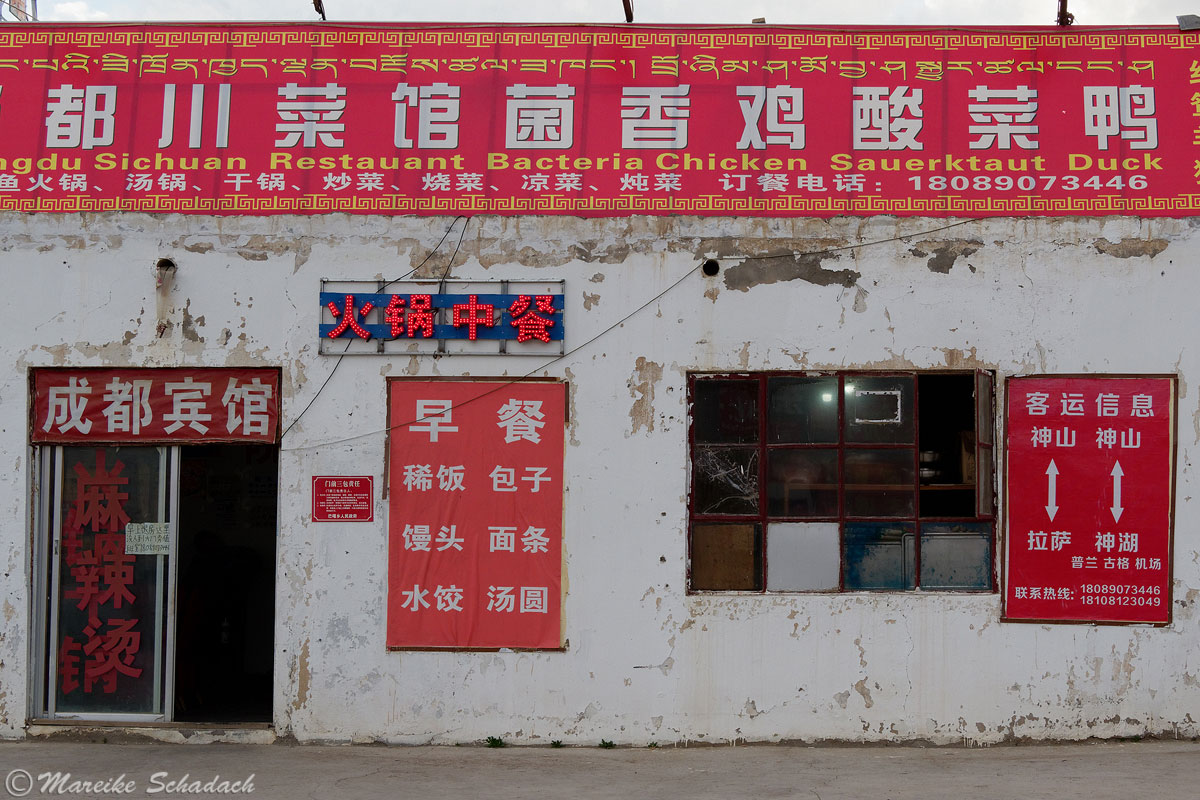

Preparing for the Altitude
A sobering fact: Even if you're in such good shape, it doesn't protect you from altitude sickness. Even endurance pros may not be able to stand the altitude. In contrast, people with low endurance do not have to suffer from altitude sickness. However, it helps a lot when hiking uphill if you are in good shape and have strong thighs. So you should try to bring along a physical fitness appropriate to the tour.
If you want to know more about altitude sickness, I can recommend a medical consultation. For example, the Berliner Centrum für Reise- und Tropenmedizin (BCRT, Berlin Centre for Travel and Tropical Medicine) also tests altitude fitness. For one hour, you breathe oxygen-reduced air simulating an altitude of 3,500 meters. Meanwhile, your pulse, blood pressure and oxygen content in the blood are regularly monitored. Based on this data, the doctor can then tell you how well and quickly your body adapts to the altitude. You can also get a prescription for Diamox (acetazolamide) against altitude sickness.
Altitude Training
If you want to prepare further, you can also do a so-called altitude training. However, it has little to do with actual training, because you only sit on a chair for one hour and breathe oxygen-reduced air. The training should be repeated at least five times and one or two weeks before your planned departure. At the end of my training, an altitude of 5,500 m was simulated - I already felt a clear effect there. And it was interesting to see how the oxygen content in my blood immediately increased again through deep and conscious breathing. That was very helpful in the real mountains.
In summary, here are the most important measures for the prevention of altitude sickness:
- Plan sufficient time for the altitude acclimatization and slowly gain altitude. Up to 500 m altitude gain per day above 2,500 m is recommended.
- If you can influence this: the sleeping places should be lower than the maximum reached during the day.
- Drink plenty of water, if necessary enrich the water with minerals.
- Pay attention to deep breathing
- Pack Ibuprofen and Diamox in the first-aid kit and use them responsibly
Since I had already had some bad altitude experiences during a trip in the Himalayas a few years earlier, I became more cautious. That's why I took a tablet of Diamox in the afternoon to prevent altitude sickness on the two days we stayed over 5,000 m above sea level. Unfortunately, a frequently observed side effect also occurred in the evening: the tingling in the hands.
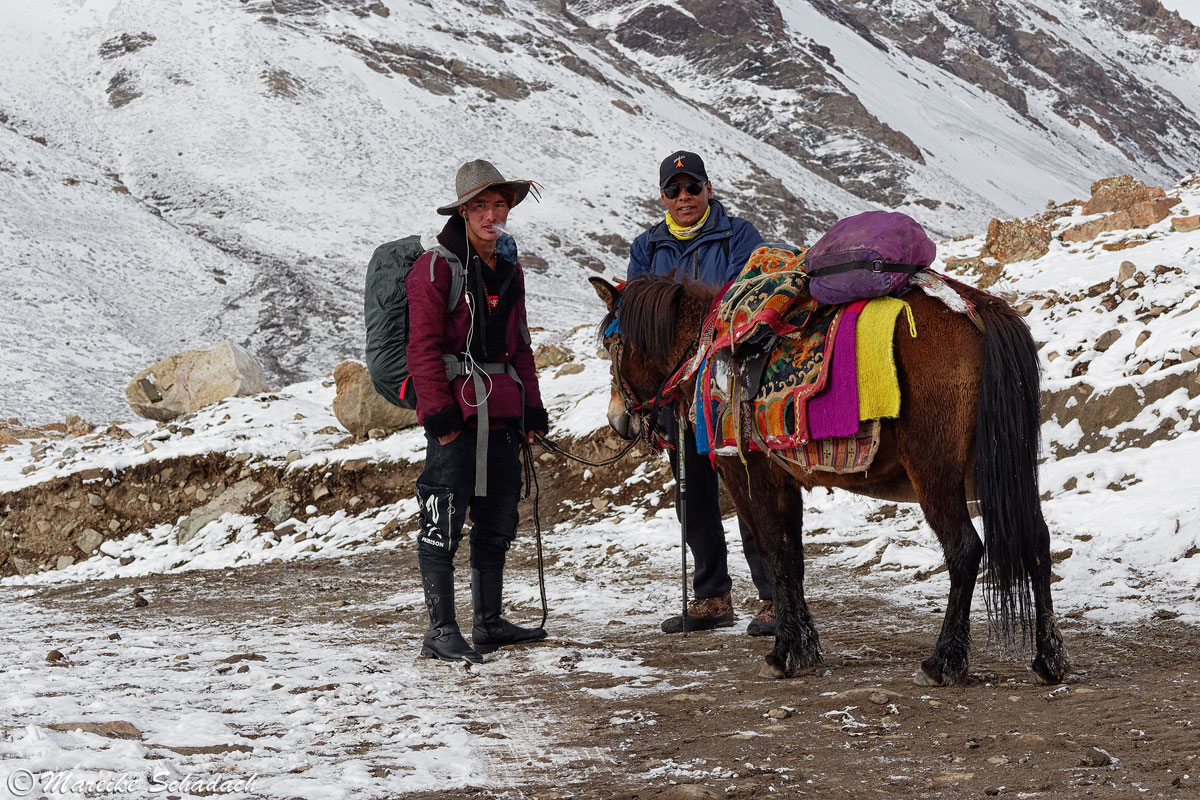
Packing List
In the following I have listed a few things I didn't want to miss when trekking around the Kailash:
- 2 trekking poles
- Solid waterproof and shrunk trekking boots
- rain gear
- thermal underwear
- warm, waterproof gloves
- good sunglasses, preferably glacier goggles with side wind protection
- Sunscreen
- Lip care with UV protection
- Warm sleeping bag
- Handkerchiefs (also as toilet paper)
- Wet wipes as a replacement for a shower
- Head lamp
- Sufficiently charged replacement batteries for the camera (does not expect power in the inns)
- Possible power station for mobile phone
- Snacks, e.g. dried fruits, nuts, chocolate bars
- Thermoskanne und Teebeutel, ggf. Instantkaffee. In den Verpflegungszelten und den Gasthäusern könnt ihr kostenlos heißes Wasser bekommen.
- Ibuprofen for high altitude headaches
- Throat candies and sea salt nasal spray if you have sensitive mucous membranes. They dry out quickly due to the high altitude air.
Long tested and much loved: my three companions on photo tours: the lightweight carbon tripod CT-5C I from Rollei*, the cleaning kit from Rollei*and my indestructible camera backpack, the camera backpack, the Flipside from Lowepro*.

Epilog
With the trekking around the Kailash, have I now got rid of all the sins of my life, as the Buddhists and Hindis believe? Maybe I am a little closer to enlightenment? Or did I only take sore muscles from the Kora with me? Now that I'm back in Darchen at a pleasant 4,650 m above sea level, even the slightest effort still takes my breath away. So I ask myself afterwards how I made it over the 5,630 m high pass. The night before I had slept only about one hour. In the morning after breakfast I told my partner that my energy level was close to zero.
It was still dark. Completely overtired I adjusted my trekking poles to the right length. Suddenly a person from the group started the discussion whether we should not turn back. She did not feel up to the conditions. Then it became clear to me how much I at least wanted to try the pass crossing. We can still turn back. I was very grateful to our guide, who encouraged everyone and assured our comrade-in-arms to stay by her side and support her if necessary. Shortly afterwards our small group set off. And everyone arrived safe and sound.
On the tour I learned a lot about myself, about my mobilizable energy reserves and my own limits. Especially how to reach a seemingly distant goal in small, continuous steps (here even literally). The conscious concentration on only the next step helped mr a lot. And despite all my efforts I had a happy smile on my face the whole time. And that evening a new wish took root in my head: to tackle my first 6,000 and then a 7,000.
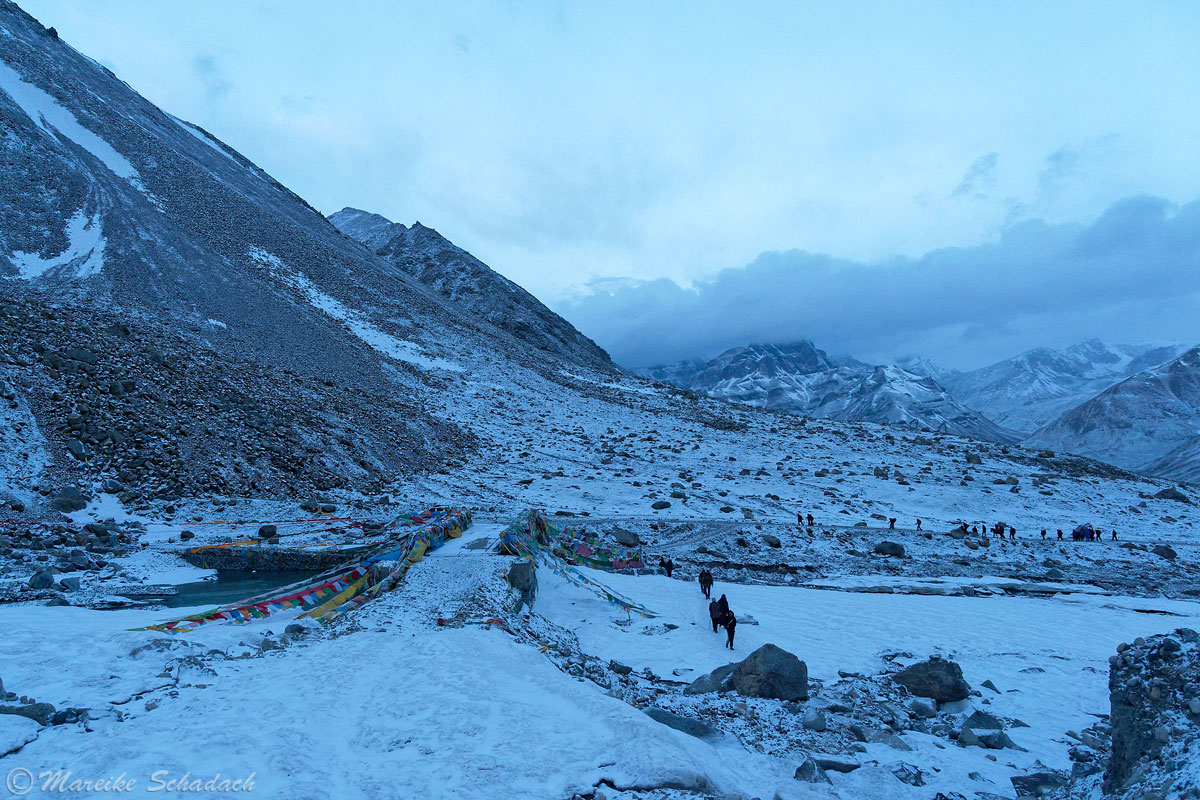
Book Recommendations for Tibet
You want to know where the journey goes? Then I can recommend these books* about Tibet.
You can order these books at Amazon with a click on the pictures. If you buy a product via one of these affiliate links, I get a small commission and you help me to keep filling Fernweh-Motive with interesting articles. The product will not be more expensive for you.
Have you ever been to Tibet yourself and circumnavigated Mt. Kailash? How did you like it? Do you have any questions about my article or suggestions? If so, please write me a comment!
Do you want to know when there are new articles on my blog? Then follow me on Facebook, Pinterest or Instagram. I would also be very happy if you share my article with your friends.
Recommendations for further Reading
Do you love road trips as much as I do? Then you might also be interested in my articles about a Climbing Mount Kenya or about a road trip through Svaneti, with the high mountains of the Georgian Caucasus.
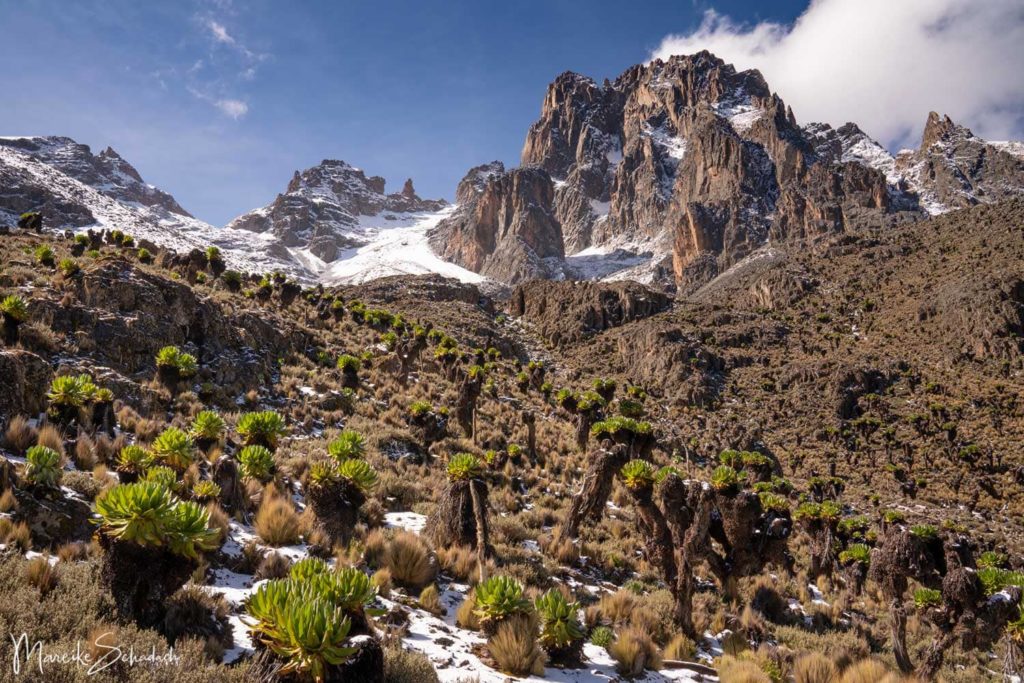
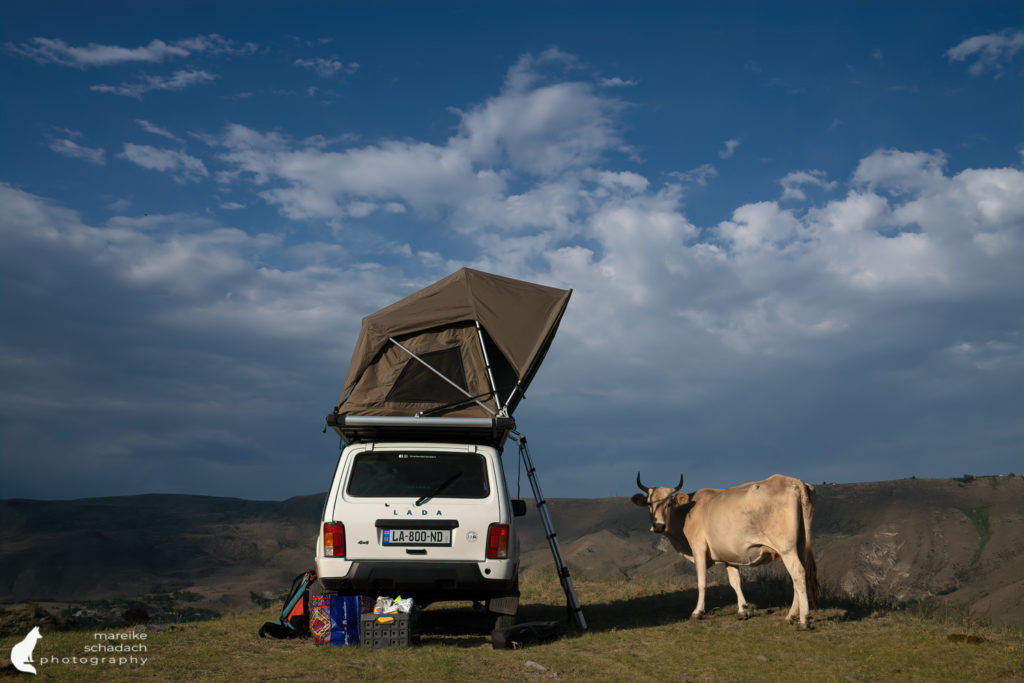
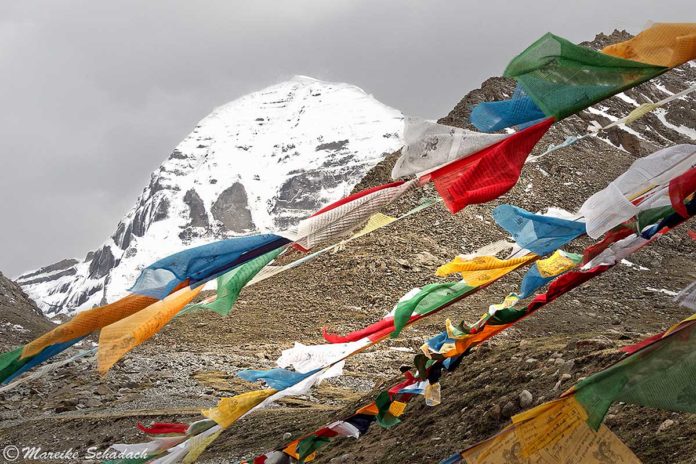








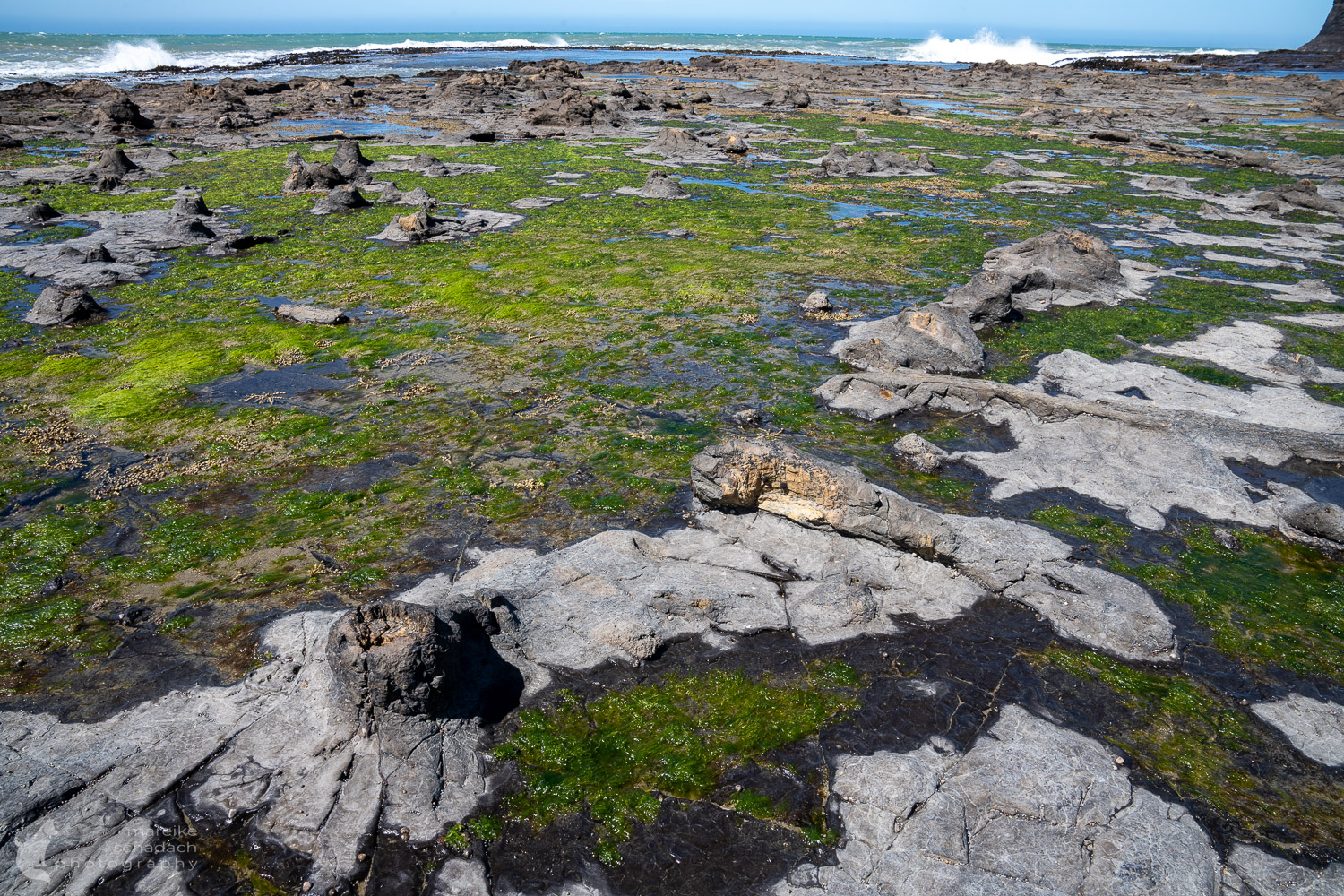


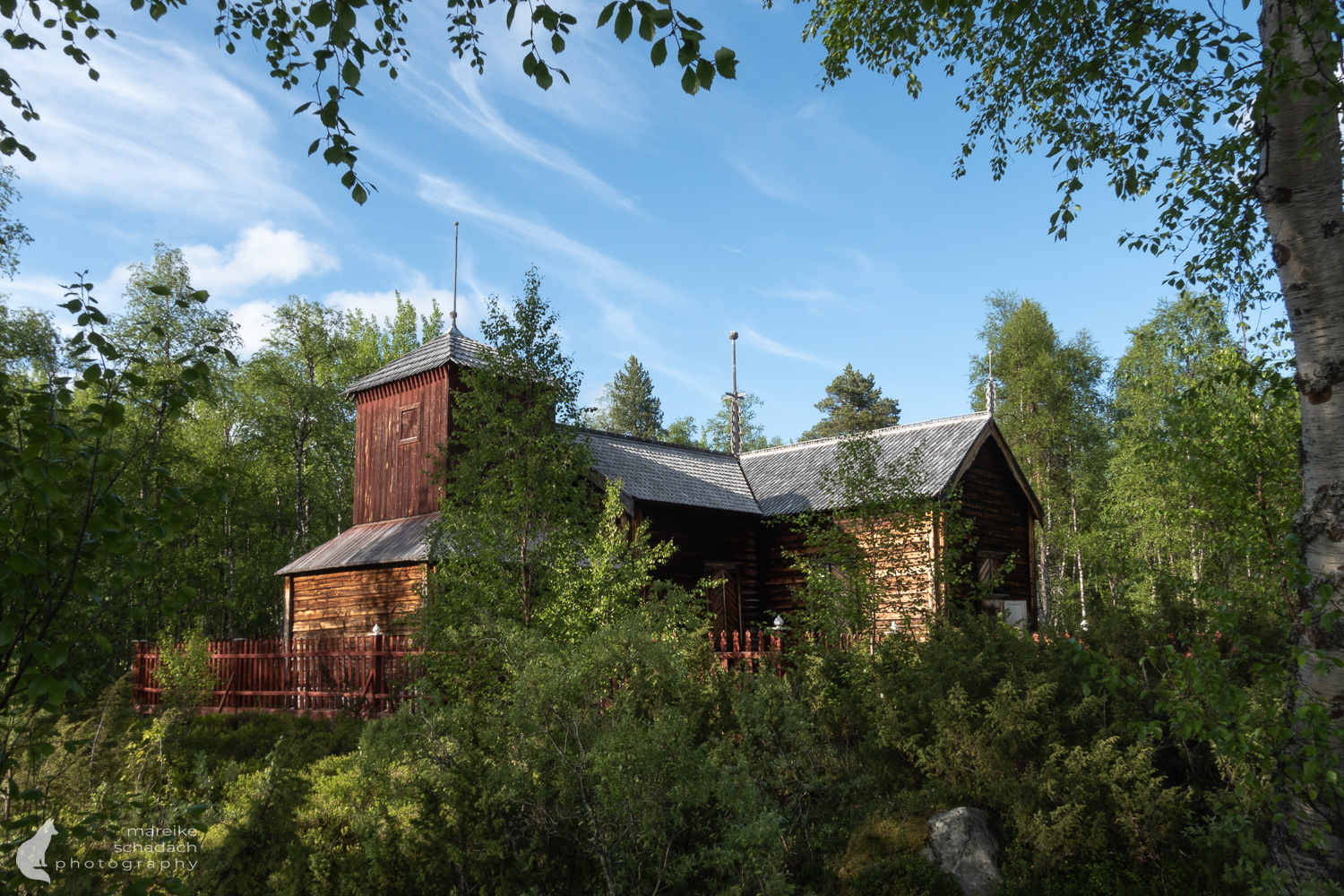
Einmal im Leben das Mount Kailash zu umrunden ist ein Traum für Tibetaner, auch viele Gläubiger aus Indien und Nepal sehen eine Kailash Umrundung ein Muss. Wir ware fünf mals am Kailash gewesen und den heiligen Berg komplett umrundet, einfach unbeschreiblich!!! Unterwegs haben wir viele nette und freundliche Einheimische und Pilgern kennengelernt, die gemeinsames Glaube wie wir haben. Also wir werden ganz sicher eine neue Reise zum Kailash planen!
Ganz lieben Dank für euer Kommentar. Der Mount Kailash ist so ein beeindruckendes Reiseziel, da kann man wirklich mehrmals hinfahren. Ich wünsche euch alles Gute für eure Touren!